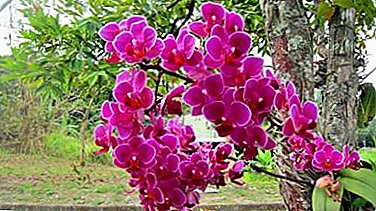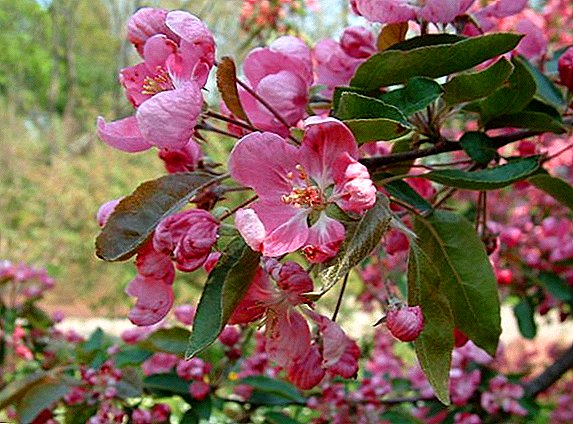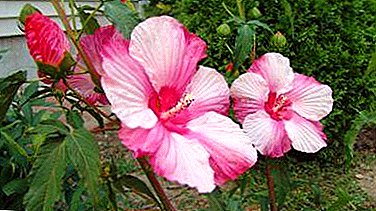
Phalaenopsis - the ideal plant for novice gardeners. The flower is completely unpretentious in the care. It is distinguished by its beauty and brightness.
When it comes to orchids, most people imagine the lush phalaenopsis inflorescence. It is about the life of this variety of orchids in the wild and will be discussed later in the article. For clarity, we will acquaint you with photographs of examples of phalaenopsis growth in nature.
In which parts of the world is it spread?
Phalaenopsis is home to Southeast Asia. A large number of species grows in the Philippines and northeastern Australia. It is believed that the genus appeared in southern China, and then spread to other parts of the world.
The sensation of this plant was only after it came to the famous scientist Carl Lynne. It was he who described this flower in his work "The Species of Plants", and called it "adorable lovely", which translates as "living on a tree."
Where and how to grow?
 Phalaenopsis genus includes more than 70 species. Most of them are epiphytes - flowers that do not root in the soil and live on other plants, using them as "supports" or supports. Useful substances flowers take from the fallen leaves, bark, moss.
Phalaenopsis genus includes more than 70 species. Most of them are epiphytes - flowers that do not root in the soil and live on other plants, using them as "supports" or supports. Useful substances flowers take from the fallen leaves, bark, moss.
Moisture is obtained from the air, because in rainforest there are often heavy rains, and in the morning there is a thick fog. Although phalaenopsis and epiphyte, but they do not climb high, but prefer to grow in the lower tiers of the forest. Favorite places - shaded area in a swamp or near rivers and lakes. There are varieties that live only on stones.
Life cycle
Under natural conditions, the plant blooms several times a year.. Phalaenopsis has practically no rest period, although it is observed by other representatives of orchids. The climate in which the flower grows, rarely changes. There are no sudden changes in temperature or cold snaps, and this contributes to constant growth.
There is a concept of both biological and forced rest. After a new shoot grows, the flower retires. This happens under favorable climatic conditions.
Important! If the temperature, moisture or any other conditions are not suitable for him, then the phalaenopsis enters the phase of forced rest and waits for the right moment to awaken.
What does a wild flower look like, photo
Phalaenopsis - monopodial flower with one short stem growing up. Near the ground there is an outlet with thick and juicy foliage, which absorbs moisture and nutrients. In length, the leaves can reach from 6 to 30 centimeters, everything depends on the variety. Sometimes there is a characteristic light color pattern on the leaf plates.
Peduncle slender and tall, large blooming flowers resembling a butterfly bloom on it. Sizes range from 3 to 30 centimeters. During flowering on one flower stalk appears from 5 to 40 flowers, it all depends on how healthy phalaenopsis is. In the wild, quantities can reach hundreds.
The color scheme is quite diverse. The plant is of different shades: white, blue, light and bright yellow, dark purple. Petals are covered with unusual patterns.
The roots are aerial, green. They take an active part in photosynthesis along with the leaves.





We also offer you to watch a video on what an orchid looks like in the wild:
Comparison of wild and domestic plants
Phalaenopsis fell in love with not only flower growers, but also breeders, who bred more than 5 thousand species.
Attention! But similar flowers have practically nothing to do with wild flowers.
- Artificially bred plants do not need to rely on anything, as wild flowers do. Without it, they grow perfectly vertically, and do not hang down from the trunks of trees.
- The flowers of domestic species are much larger, but their number is several times smaller than that of phalaenopsis growing in tropical forests.
- In nature, an orchid can live for up to 100 years, but in a residential environment, life is limited.
- But both home and wild, the flower needs a warm climate and high humidity.
Why is called a miracle of nature?
The color of the flowers is so original and bizarre that in Europe they began to be called the "miracle of nature". Also, this name is due to the fact that in some species the clusters grow down, that is, hang from the trees, and this is quite a rare phenomenon.
Interesting fact
The name familiar to people appeared in these flowers in 1825. The director of the Leiden Botanical Garden, Karl Blume, traveled through the Malay Archipelago and discovered huge white flowers in the thick of the rainforest on high stems. He took them for night moths. It was a mistake that quickly revealed, but Blume decided to call these flowers falenopsis - from the Greek words phalania - “moth” and opsis - “similarity”.
Conclusion
Amazing exotic orchids Phalaenopsis - a real miracle of nature, which a skilled florist can easily settle in their home. The flower does not take a lot of trouble, and will always please the eye with lush bloom.












